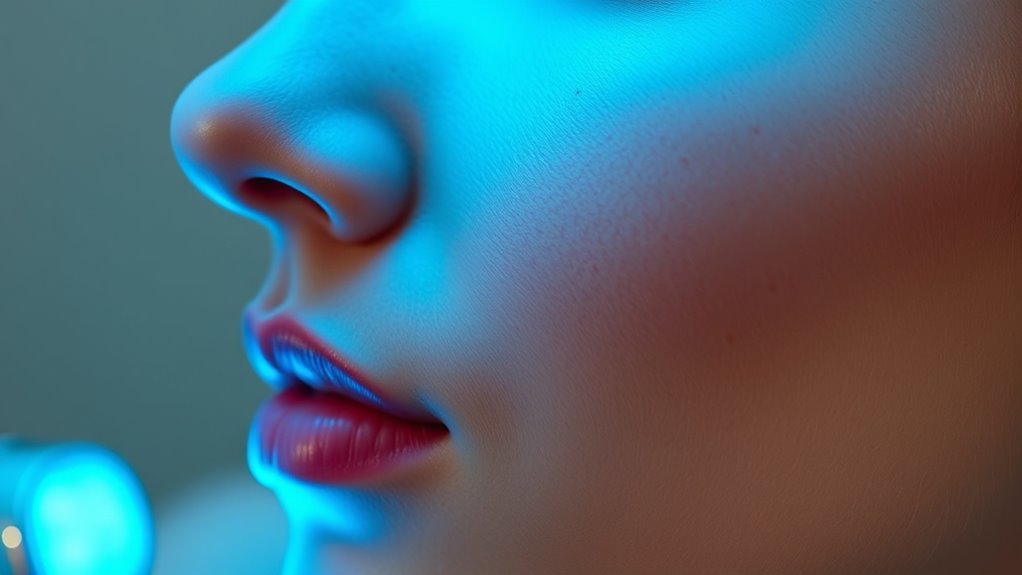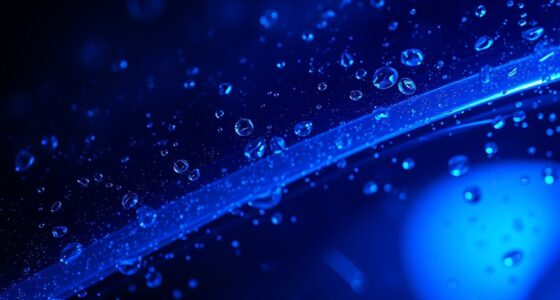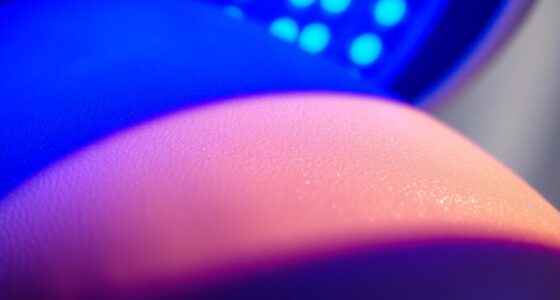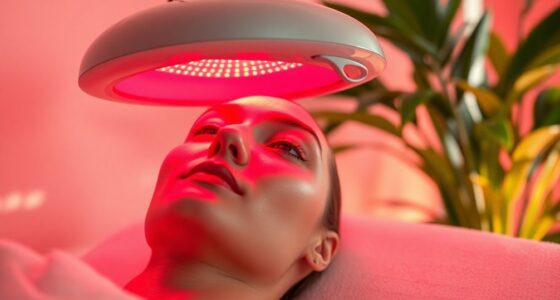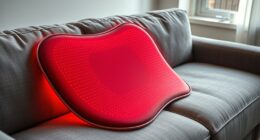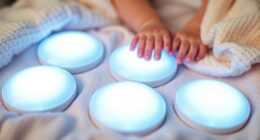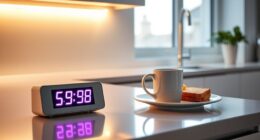Blue light therapy can help calm mild to moderate acne by targeting acne-causing bacteria and reducing inflammation. It’s a safe, non-invasive option that doesn’t cause side effects like peeling or redness. Sessions are usually quick and painless, with results gradually improving over time. While it’s effective for many, it might not work as well for severe or cystic acne. Keep exploring to find out how this treatment could fit into your skincare routine.
Key Takeaways
- Blue light targets acne-causing bacteria and reduces inflammation, helping to calm and improve acne-prone skin.
- Sessions are painless, with a mild warmth, and generally safe for sensitive skin types.
- Consistent treatments over time can lead to gradual acne improvement and skin calming effects.
- Blue light therapy offers a drug-free, non-invasive option with minimal side effects and no recovery time.
- It is most effective for mild to moderate acne and works best when combined with gentle skincare routines.
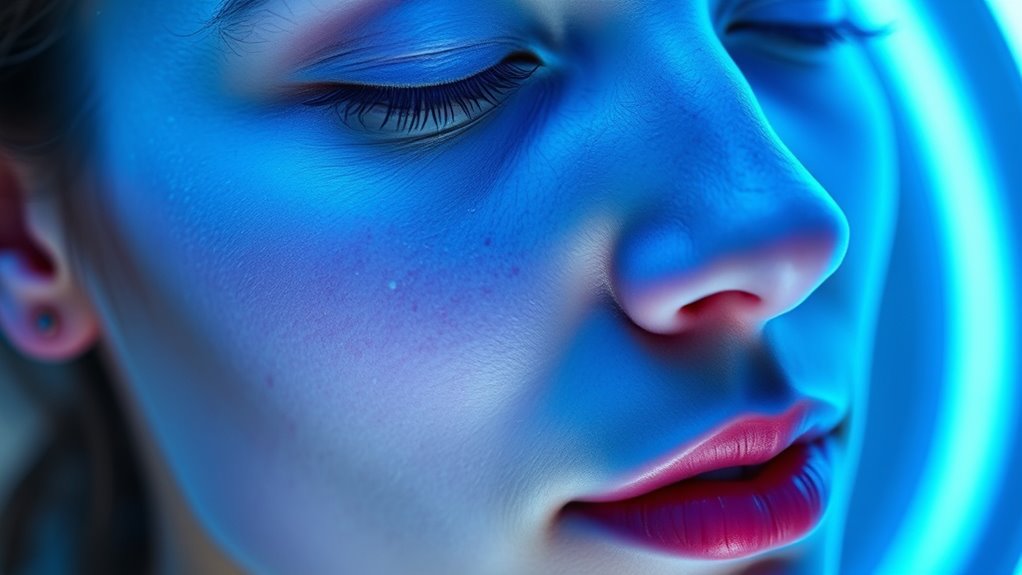
If you’re struggling with stubborn breakouts, blue light therapy might be worth considering. This treatment has gained popularity as a non-invasive way to target acne-causing bacteria and reduce inflammation. The blue light, typically in the range of 405 to 420 nanometers, penetrates your skin and activates a process that kills Propionibacterium acnes, the bacteria responsible for many types of acne. Unlike topical creams or oral medications, blue light therapy offers a drug-free alternative with minimal side effects. You might find it appealing if you’re seeking something gentle yet effective, especially if traditional treatments haven’t delivered the results you want.
When you undergo blue light therapy, the process is straightforward and usually painless. You’ll sit or lie down in front of a device that emits the blue light, often for sessions lasting about 15 to 30 minutes. During this time, you should feel nothing more than a mild warmth on your skin. Many clinics recommend a series of treatments—sometimes weekly or biweekly—to see noticeable improvements. The benefits tend to build over time, with clearer skin emerging after several sessions. Some people report a reduction in the number and severity of breakouts after just a few treatments, while others may need longer to see significant results.
One of the main advantages of blue light therapy is its safety profile. Since it’s a non-invasive procedure, there’s no need for anesthesia or recovery time. You won’t experience the peeling, irritation, or redness often associated with chemical peels or strong topical medications. This makes it an appealing option if you have sensitive skin or are wary of side effects. Additionally, blue light therapy doesn’t involve systemic drugs, so it won’t interfere with other medications you might be taking. It’s also drug-free, which appeals to those seeking a more natural approach to skincare.
However, it’s important to keep your expectations realistic. Blue light therapy isn’t a cure-all and works best for mild to moderate acne. It may not be as effective for cystic or severe acne, which often requires more aggressive treatments. You should also remember that individual results vary; some people see significant improvements, while others might notice only minor changes. To maximize benefits, it’s best to combine blue light therapy with a consistent skincare routine, including gentle cleansing and non-comedogenic products. Additionally, choosing an electric flat iron bike for your skincare routine might help improve your overall skin health through alternative methods.
If you’re considering this treatment, consult with a dermatologist or skincare professional. They can assess your skin type, severity of acne, and whether blue light therapy is suitable for you. When done correctly and combined with other good skincare habits, blue light therapy can be a safe, effective option to help calm your skin and reduce breakouts, giving you a clearer complexion and more confidence.
Frequently Asked Questions
How Long Does It Take to See Results From Blue Light Therapy?
You can usually start seeing improvements from blue light therapy within a few sessions, often after 2 to 4 treatments. Some people notice clearer skin after just one or two visits, but for more significant and lasting results, it might take 4 to 6 weeks of consistent therapy. Keep in mind, individual responses vary, so patience and regular sessions are key to achieving the best outcome.
Is Blue Light Safe for All Skin Types and Tones?
Yes, blue light is generally safe for all skin types and tones. You can use it without worrying about significant side effects, but if you have very sensitive skin or certain skin conditions, it’s wise to consult a dermatologist first. Blue light treatment targets bacteria and reduces inflammation, making it suitable for most people. Just follow the recommended guidelines and monitor your skin’s response to ensure safe, effective results.
Can Blue Light Be Combined With Other Acne Treatments?
Yes, you can combine blue light therapy with other acne treatments. It often works well alongside topical medications, like benzoyl peroxide or salicylic acid, and oral antibiotics. Just make sure to consult your dermatologist first to verify compatibility and avoid irritation. Combining treatments can boost your results, but it’s important to follow professional advice to safely integrate blue light into your skincare routine.
Are There Any Side Effects From Blue Light Therapy?
You might experience minimal side effects from blue light therapy, like a slight redness or dryness—think of it as a gentle sun kiss on your skin. These effects are usually temporary and fade quickly. Rarely, some people may notice mild irritation or sensitivity. But overall, blue light therapy is safe, and serious side effects are extremely uncommon. You’ll likely find it a soothing, side-effect-free way to combat acne.
How Often Should Blue Light Treatments Be Performed for Best Results?
You should perform blue light treatments two to three times a week for the best results. Consistency is key, so stick to this schedule to help reduce acne-causing bacteria and inflammation effectively. Avoid overdoing it, as too frequent sessions might cause irritation. Follow your dermatologist’s advice, and remember that results can vary, so patience and regular treatments are essential for clearer skin.
Conclusion
In the end, blue light therapy shows promise in calming breakouts, but it’s not a magic cure-all. Consistency and patience are key—remember, Rome wasn’t built in a day. While it can help reduce inflammation and bacteria, combining it with a good skincare routine yields the best results. Don’t forget, “slow and steady wins the race,” so give your skin time to heal and adapt for clearer, calmer skin.
